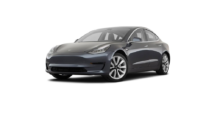Before Driving
When snow and ice accumulate on your vehicle, moving parts, such as the door handles, windows, mirrors, and wipers can freeze in place. To achieve maximum range and performance, it is helpful to warm the cabin and Battery before you leave. There are several ways to do so:
- Touch Schedule, available on both the charging and climate control screens, to set a time when you want your vehicle to be ready to drive (see Scheduled Charging and Scheduled Departure).
- On the mobile app, navigate to Climate to customize the temperature at which you want to heat the cabin. This also warms the high voltage battery as needed.
- On the mobile app, navigate to to melt snow, ice, and frost on the windshield, windows, and mirrors. This also warms the high voltage battery as needed. NoteTesla recommends activating climate settings at least 30-45 minutes before departure (see Climate Controls). Preconditioning times depend on outside temperature and other factors. The Mobile App will notify you once your vehicle has reached the desired preconditioning temperature.
- In extremely cold weather or icy conditions, it is possible that your charge port latch may freeze in place. In cases where you cannot remove or insert the charging cable, or the vehicle is not Supercharging due to the latch being frozen in place, use the Defrost Car setting in the mobile app. This can help thaw ice on the charge port latch so the charging cable can be removed or inserted.
- Warming the Battery using Scheduled Departure or the mobile app before driving can also reduce charging time at a Supercharger or third party fast charger, especially if the Supercharger or third party fast charger is close enough that Trip Planner does not have sufficient time to precondition the Battery (see Warming the Battery Before Supercharging).
Windows
- On the mobile app, navigate to as mentioned previously.
- Use the mobile app to schedule a service appointment for Tesla to provide a hydrophobic coating to your windows for a nominal fee.
Mirrors
If ice buildup is expected when parking, turn off Auto-Fold Mirrors. Touch . Ice can prevent exterior side mirrors from folding or unfolding.
Wipers
If you expect snow or ice to build up when parked, touch . This raises wipers against the windshield so they can defrost when the windshield defrosts (see Wipers and Washers). You can also turn on wiper defrosters (if equipped). See Climate Controls.
Tires and Tire Chains
- Use winter tires to increase traction in snowy or icy conditions. You can purchase winter tires on http://www.tesla.com (see Seasonal Tire Types).
- Tire chains provide additional traction when driving in snowy or icy conditions. Check local regulations to determine if tire chains are recommended or required during winter months. See Using Tire Chains for more information.
Your vehicle’s tire pressures will drop in cold ambient temperatures. If the TPMS indicator light appears, inflate the tires before driving. The tires will lose one PSI for every 10° F (6° C) drop in outside temperature (see Tire Care and Maintenance). Proper tire pressures help protect tires from potholes and improve range when properly inflated.






